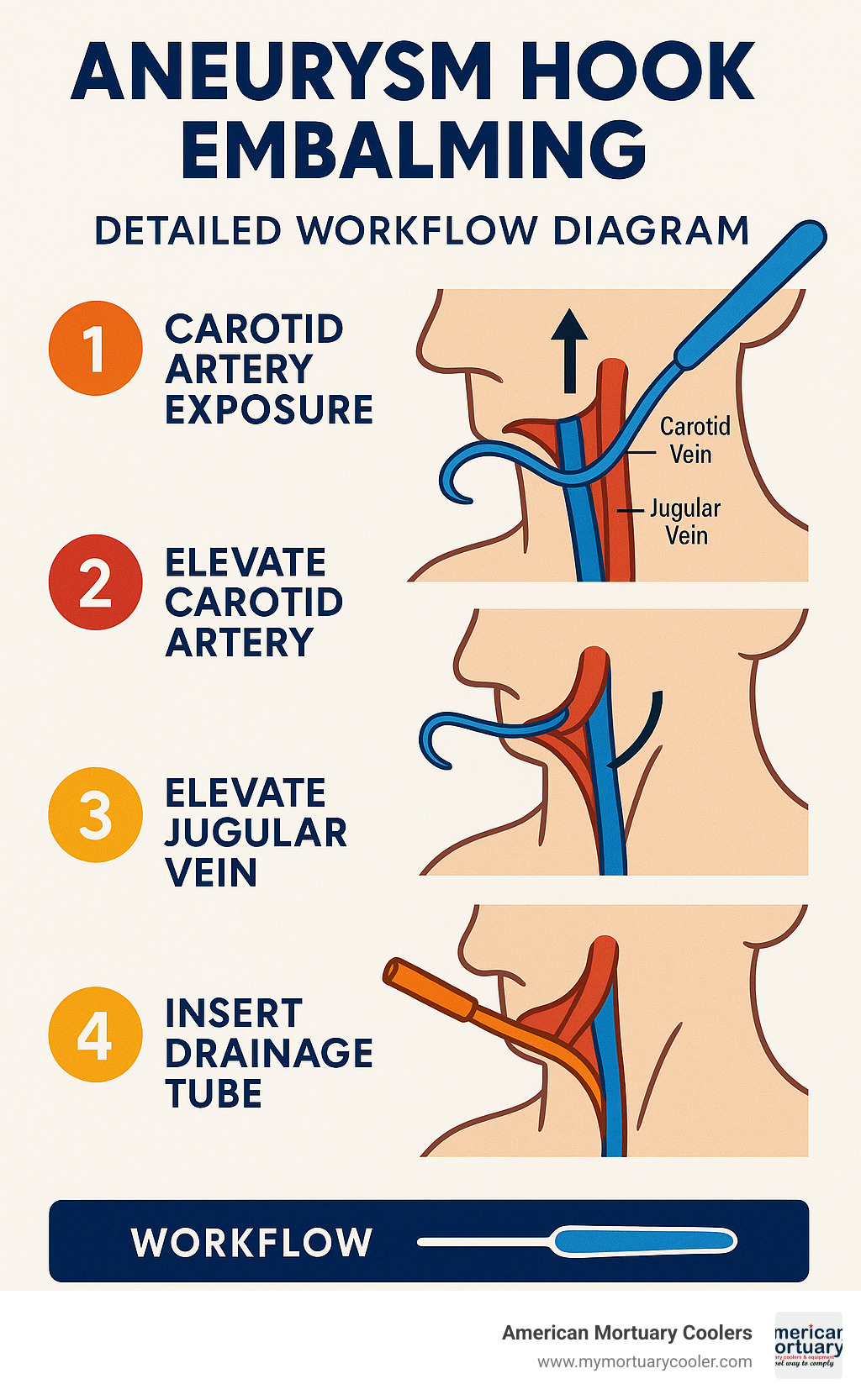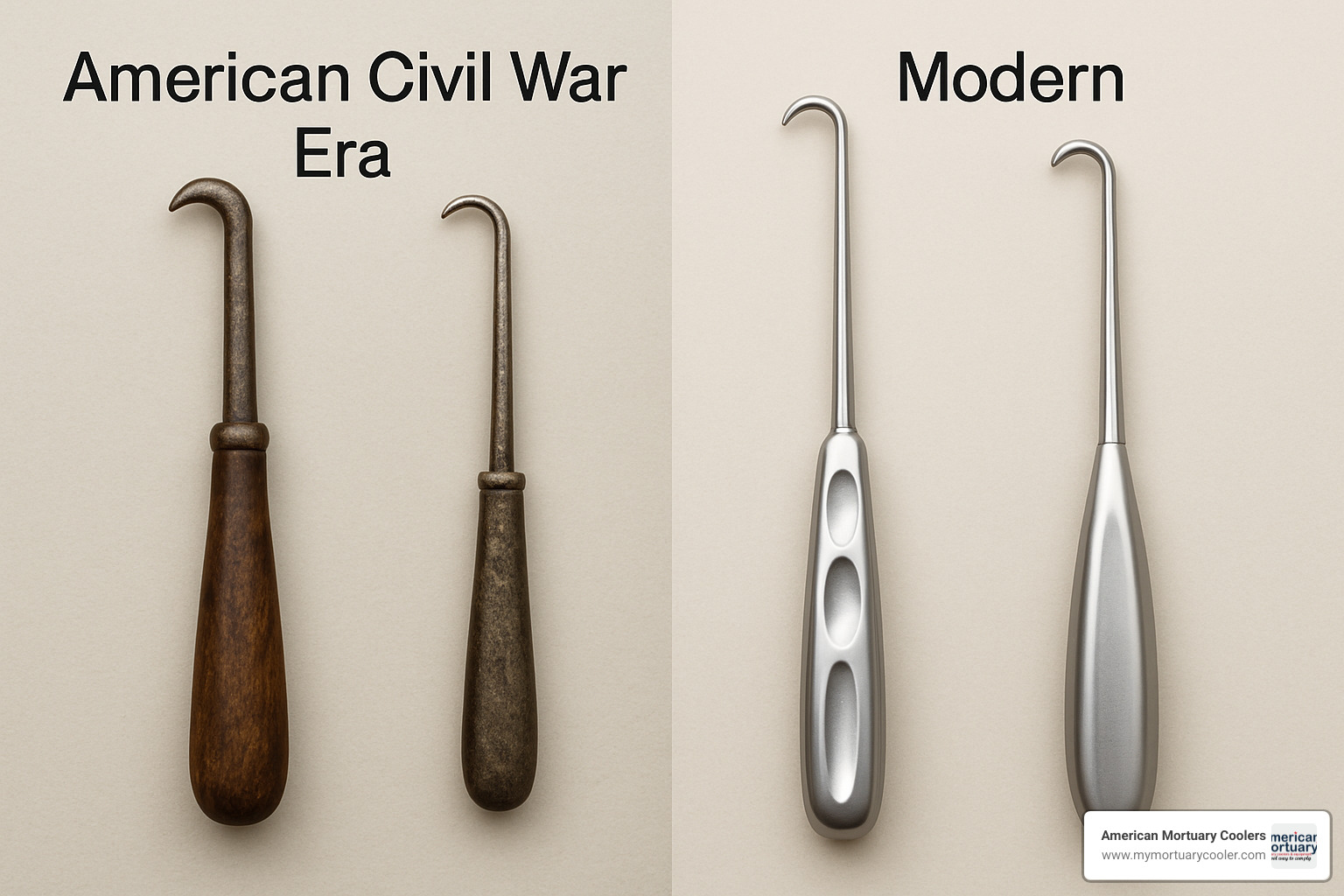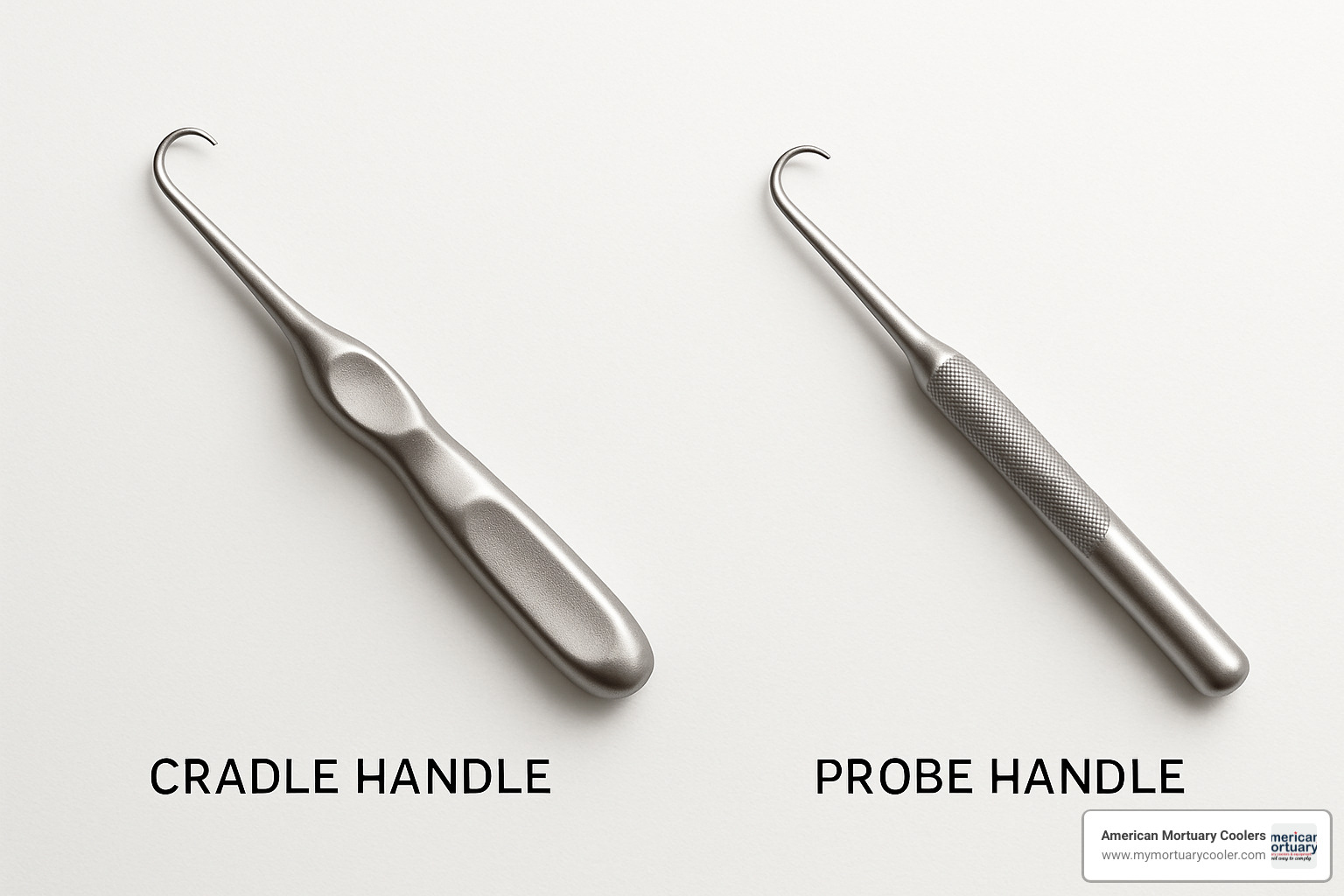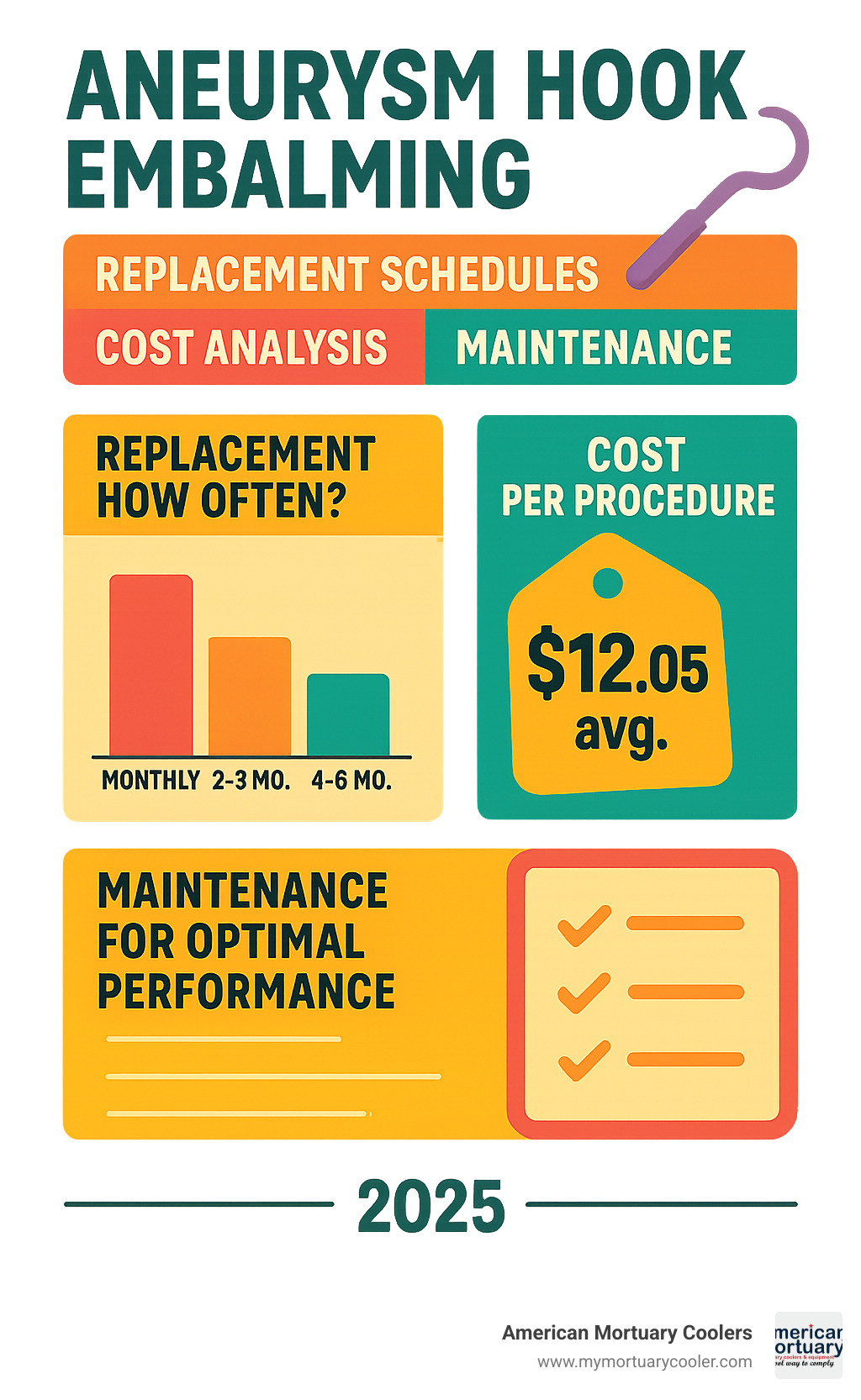Why Aneurysm Hook Embalming is Essential for Modern Funeral Directors
Aneurysm hook embalming is the process of using a specialized curved hook instrument to raise and manipulate arteries and veins during embalming procedures. This technique allows embalmers to properly expose blood vessels for arterial injection and drainage without damaging delicate tissue.
Quick Reference: Aneurysm Hook Embalming Basics
- Primary Function: Raises carotid artery and jugular vein from neck incision
- Design: 6-6.5 inch stainless steel hook with blunt or sharp tip
- Key Benefit: Enables precise vessel manipulation without twisting or tearing
- Usage: Required in nearly every arterial embalming procedure
- Cost: Ranges from $7.95 to $19.43 USD per instrument
The aneurysm hook ranks among the top 10 most commonly used instruments in embalming procedures. Without proper vessel-raising techniques, embalmers struggle to achieve uniform fluid distribution and effective blood drainage - two critical factors for quality preservation results.
As Sir William Gladstone once noted, "Show me the manner in which a nation cares for its dead..." This care begins with proper embalming technique, and the aneurysm hook plays a vital role in that process.
I'm Mortuary Cooler, a national-level mortuary cooler supplier with extensive experience helping funeral homes optimize their embalming operations through reliable equipment solutions. My work with funeral directors across the country has shown me how proper aneurysm hook embalming techniques directly impact service quality and operational efficiency.

Simple guide to aneurysm hook embalming:
Aneurysm Hook Fundamentals: History, Functions, Benefits
The aneurysm hook might look like a simple curved instrument, but it's one of the most ingenious tools in the embalmer's arsenal. We've seen countless funeral directors transform their embalming efficiency once they master this essential technique.

Think of the aneurysm hook as your precision tool for vessel manipulation. This curved, probe-like instrument was specifically designed to raise arteries and veins from surrounding tissue during aneurysm hook embalming procedures. The name comes from its original medical use in vascular surgery, but in our world of mortuary science, it's become the go-to tool for vessel elevation.
Most modern aneurysm hooks measure 6 to 6.5 inches long and are crafted from high-grade stainless steel. You'll find them available with either blunt or sharp tips. The blunt tip variety has become incredibly popular because it dramatically reduces the risk of accidentally puncturing vessels during manipulation - trust me, that's a mistake you only want to make once.
Primary Functions in Modern Embalming
The aneurysm hook serves as your reliable partner for three critical tasks during embalming procedures.
Arterial exposure is where this tool really shines. The hook gently separates the carotid artery from surrounding connective tissue and the adjacent jugular vein. This separation isn't just helpful - it's absolutely crucial for inserting arterial tubes without interference from other structures.
Vein elevation comes next in the process. Once you've isolated the artery, the hook helps lift the jugular vein for drainage tube insertion. Here's something that might surprise you: up to 50% of what drains during arterial injection can actually be embalming solution. That makes efficient drainage critical for both preservation quality and cost control.
Drainage assistance rounds out the hook's primary functions. Throughout the embalming process, you can use it to reposition vessels, clear stubborn blockages, and ensure optimal fluid flow. This becomes especially important when dealing with challenging cases involving edema or vascular disease.
Historical Evolution and Regional Practices
The story of aneurysm hook embalming stretches back thousands of years. Ancient Egyptian embalmers used primitive bronze probes to manipulate vessels during mummification. But modern arterial embalming really took off during the American Civil War.
Thomas Holmes, often called the "father of American embalming," introduced arterial embalming techniques to preserve soldiers for transport home. His innovations, including vessel-raising techniques, revolutionized mortuary practice. The Historic overview of arterial embalming shows how Holmes' work laid the foundation for modern embalming methods.
The psychological importance of viewing properly embalmed remains became crystal clear during President Lincoln's 1650-mile funeral tour. This demonstrated just how critical quality embalming had become in the grieving process.
Interestingly, regional variations in aneurysm hook techniques developed over time. UK vs US techniques show some fascinating differences. British practitioners tend to favor hooks without eyes, while American embalmers often prefer the eye version for threading ligatures. These preferences reflect different approaches to vessel ligation and tube securing methods that evolved independently on either side of the Atlantic.
How to Perform Aneurysm Hook Embalming: Step-by-Step Techniques
Mastering aneurysm hook embalming is like learning to ride a bicycle - it takes practice, but once you get it, the technique becomes second nature. After working with countless funeral directors across Tennessee and beyond, I've seen how proper preparation and steady hands make all the difference.
The beauty of aneurysm hook embalming lies in its neat simplicity. You make a precise incision, use the hook to gently separate the carotid artery from the jugular vein, then insert your arterial and drainage tubes. When executed correctly, this technique delivers optimal fluid distribution while ensuring efficient blood drainage - the foundation of quality preservation work.
Pre-Embalming Setup
Before you even think about picking up that aneurysm hook, proper setup is absolutely critical. We always tell our clients that preparation prevents poor performance - and nowhere is this more true than in embalming procedures.
Your workspace should be organized and efficient. Sharp scalpel for the initial incision, aneurysm hook (we recommend blunt tip for those still building confidence), angular spring forceps as your backup, plus arterial and drainage tubes ready to go. Don't forget your ligature material - black thread works beautifully because it's less visible in the final presentation.
Personal protective equipment isn't optional - it's essential. Latex or nitrile gloves, protective eyewear, and appropriate gowns are your first line of defense. As one embalmer joked with me recently, "My latex gloves in 'Fierce Beige' match my personality perfectly!" Whatever color suits your style, make sure they fit properly and get changed between procedures.
Disinfectant solutions should be within easy reach throughout the process. OSHA standards and universal precautions aren't suggestions - they're requirements that protect both you and your staff.
For comprehensive preparation guidelines and equipment sourcing, our detailed guide on embalming supplies covers everything you need to know.
Aneurysm Hook Embalming: Vessel-Raising Protocol
Now comes the heart of aneurysm hook embalming - the actual vessel-raising technique that separates skilled embalmers from beginners. This process requires patience, gentle movements, and respect for the delicate nature of human tissue.
Start with your incision - a clean 2-3 inch cut along the medial border of the sternocleidomastoid muscle, right at the level of the thyroid cartilage. Think of it as opening a door rather than forcing your way through.
Locate the carotid sheath using blunt dissection techniques. Inside this protective covering, you'll find the common carotid artery, internal jugular vein, and vagus nerve all nestled together. Your job is to gently separate these structures without damaging any of them.
Insert the aneurysm hook with the same care you'd use threading a needle. Slide it beneath the carotid artery, letting the hook's natural curve follow the vessel's contour. Never force it - if you meet resistance, back up and try a different angle.
Separate the vessels by using the hook to create space between the artery and adjacent jugular vein. This separation is absolutely crucial because it gives you independent access to both vessels for tube insertion.
Lift for tube insertion while maintaining steady, controlled pressure with the hook. The vessel should stay liftd and accessible while you insert the arterial tube. The hook prevents collapse and keeps everything in perfect position.
Secure with ligature once your tubes are properly placed. If you're using an eye-equipped aneurysm hook, it can help thread the ligature material around the vessels for a secure hold.
Remember - aneurysm hook embalming succeeds through gentle, deliberate movements. Rushing or applying excessive pressure will only create problems and potentially damage delicate vessels.
Troubleshooting During Aneurysm Hook Embalming
Even the most experienced embalmers run into challenges during aneurysm hook embalming. Over the years, I've helped funeral directors work through every conceivable complication, and there's always a solution.
Vascular blockages are probably the most common frustration. When fluid flow gets restricted, use your aneurysm hook to gently massage the vessel walls and encourage clot movement. Intermittent drainage - switching back and forth between injection and drainage - often breaks loose stubborn blockages that resist other approaches.
Fragile vessels require extra finesse, especially when working with elderly individuals or cases involving vascular disease. Switch to a blunt-tip hook and reduce your pressure significantly. Sometimes pre-injection fluids can strengthen vessel walls enough to handle the preservation fluid that follows.
Edema cases present their own unique challenges because severe swelling makes vessel identification much more difficult. Higher index fluids with humectants work well here, combined with topical gels to restore more normal tissue contours. Your aneurysm hook becomes even more valuable in these situations for positive vessel identification.
Alternate injection sites become necessary when cervical vessels just won't cooperate. Femoral vessels, axillary vessels, or even individual organ injection may be your best option. The same gentle separation and elevation principles apply regardless of location - the aneurysm hook adapts beautifully to different anatomical sites.
The key to successful troubleshooting is staying calm and methodical. Massage and pressure techniques combined with careful repositioning solve most problems without requiring dramatic changes to your approach.
Design, Materials, and Comparative Advantages
Choosing the right aneurysm hook can make the difference between a smooth procedure and a frustrating struggle. After working with funeral directors across the country, I've seen how the right instrument design transforms both technique and confidence during aneurysm hook embalming.

The foundation of any quality aneurysm hook is surgical-grade stainless steel construction. This material choice isn't just about durability - though these hooks do need to withstand countless sterilization cycles. Stainless steel allows manufacturers to create precise curves and maintain sharp tip configurations that stay consistent over years of use.
When it comes to handles, you'll find three main styles that each serve different needs. The traditional probe handle offers a familiar feel similar to other surgical instruments, while the cradle handle provides a wider, more comfortable grip that reduces hand fatigue during longer procedures. For maximum control, the corrugated handle features heavy texturing that gives you superior grip even when working with wet gloves.
The choice between blunt and sharp tips often comes down to experience level and case complexity. Blunt tips are forgiving - they're much less likely to accidentally puncture a vessel during manipulation, making them ideal for newer embalmers or routine cases. Sharp tips offer more precision for challenging situations, particularly when dealing with diseased or calcified vessels that require careful dissection.
One design feature that divides embalmers is the eye configuration. Hooks with eyes allow you to thread ligatures directly through the instrument, which many American practitioners find convenient. However, hooks without eyes offer a simpler design that some embalmers prefer, especially when focusing purely on vessel manipulation rather than ligature work.
| Design Feature | Standard Length | Price Range | Best Use Case |
|---|---|---|---|
| Blunt Tip, No Eye | 175mm | $7.95-$12.00 | Routine embalming, beginners |
| Sharp Tip, With Eye | 150-175mm | $12.00-$16.00 | Complex cases, ligature work |
| Cradle Handle | 175mm | $15.00-$19.43 | Extended procedures, ergonomics |
| Probe Handle | 150-175mm | $7.95-$14.00 | Traditional technique, compact storage |
Professional organizations like the NAFD continue to emphasize proper instrument standards, and quality aneurysm hooks from reputable suppliers consistently meet these requirements. The investment in a well-made instrument pays dividends in both performance and longevity.
What sets aneurysm hooks apart from other vessel-raising tools like angular spring forceps or groove directors is their natural curved design. This curve follows the anatomical contours of blood vessels, reducing trauma during manipulation and ultimately improving preservation outcomes. The gentle approach possible with a properly designed hook translates directly to better results and fewer complications during aneurysm hook embalming procedures.
The affordability of quality aneurysm hooks - ranging from under $8 to just over $19 - makes them accessible to funeral homes of all sizes. When you consider that a single instrument can last for years with proper care, the cost per procedure becomes negligible compared to the value they provide in achieving consistent, professional results.
Safety, Maintenance, Troubleshooting & FAQs
Taking care of your aneurysm hooks isn't just about making them last longer - it's about protecting everyone involved in the embalming process. We've seen too many avoidable accidents that could have been prevented with proper maintenance and safety protocols.
OSHA compliance isn't optional when it comes to aneurysm hook embalming. Every procedure must follow bloodborne pathogen standards, which means proper PPE, careful instrument handling, and correct disposal of contaminated materials. Think of it as protecting not just yourself, but the families who trust you with their loved ones.
Storage makes a difference too. Keep your aneurysm hooks in dedicated instrument trays or cases that protect the tips and maintain sterility. We've seen countless hooks damaged because they were tossed loose in drawers - and a damaged hook can ruin an entire embalming procedure.

How do I sterilize my aneurysm hook?
Steam autoclaving remains the gold standard for sterilizing your aneurysm hooks. It's reliable, fast, and gets the job done right every time.
Start by removing all visible debris and organic matter - this pre-cleaning step is crucial for effective sterilization. Then run your steam autoclave at 121°C (250°F) for 15 minutes under 15 PSI pressure. Allow complete air drying before storage, and finish with a 70% isopropyl alcohol wipe right before use.
Chemical sterilization using glutaraldehyde solutions works too, but requires much longer contact times - typically 10 hours for complete sterilization. Always follow the manufacturer's guidelines for chemical sterilants, and remember that shortcuts in sterilization can have serious consequences.
What are common mistakes to avoid?
Through years of training embalmers across the country, we've spotted the same mistakes over and over again. The good news? They're all easily preventable once you know what to watch for.
Over-tensioning tops our list of common errors. Applying too much upward pressure can tear vessels or separate them from connecting branches. Use just enough tension to lift the vessel clear of surrounding tissue - think gentle guidance, not forceful pulling.
Twisting vessels during aneurysm hook embalming causes unnecessary damage. Rotating the hook while lifting can damage vessel walls or create kinks that block fluid flow. Keep the vessel in its natural orientation throughout the entire procedure.
Using dull or damaged tips creates problems you don't need. A bent or damaged hook tip snags tissue and causes trauma that could have been avoided. Always inspect your hooks before each use and replace damaged instruments immediately.
Inadequate separation between arteries and veins leads to cross-contamination during injection and drainage. This reduces embalming effectiveness and can compromise your results. Take the time to completely separate the vessels - it's worth the extra effort.
How often should hooks be replaced?
Monthly inspections should be part of your routine maintenance schedule. Examine all aneurysm hooks for signs of corrosion, bent tips, or handle damage. Document these inspections to maintain compliance with quality standards - and to protect yourself if questions arise later.
Replace your hooks when you notice visible corrosion or pitting on the surface, bent or damaged tips that can't be properly straightened, loose or damaged handle components, or any cracks or structural weakness in the metal.
Cost shouldn't be a concern when it comes to replacement. With aneurysm hooks ranging from $7.95 to $19.43, replacement costs are minimal compared to the potential problems caused by defective instruments. We always recommend maintaining at least two hooks per preparation room for backup availability.
Track your results to know when replacement is needed. Poor fluid distribution or vessel damage during procedures often indicates it's time for new instruments. Your embalming outcomes will tell you when your tools need attention - listen to what they're saying.
Conclusion
Mastering aneurysm hook embalming techniques represents a crucial skill for modern funeral service professionals. From its origins in Civil War battlefield medicine to today's sophisticated preservation methods, the aneurysm hook remains an indispensable tool for quality embalming results.
The key points we've covered - proper technique, instrument selection, safety protocols, and maintenance procedures - form the foundation of professional embalming practice. The aneurysm hook is used in nearly every arterial embalming procedure, making proficiency with this instrument essential for consistent, quality outcomes.
At American Mortuary Coolers, we understand that quality embalming requires more than just proper technique - it demands reliable equipment and support systems. Our custom mortuary coolers and related equipment provide the foundation for professional embalming operations across the contiguous 48 states. Whether you're located in Johnson City, TN, Atlanta, GA, Chicago, IL, or anywhere in between, our direct delivery ensures you have the equipment you need when you need it.
The durability and precision required for aneurysm hook embalming extends to every aspect of mortuary operations. Just as a quality aneurysm hook ensures proper vessel manipulation, quality cooling systems ensure optimal preservation conditions for the families you serve.
For funeral directors ready to advance their embalming knowledge beyond aneurysm hook techniques, we recommend exploring The Complete Guide to the Embalming Process as your next step toward comprehensive embalming mastery.
As Sir William Gladstone observed, the manner in which we care for the dead reflects our values as a society. Proper aneurysm hook embalming techniques ensure that care begins with the fundamental respect embodied in quality preservation practices.
















